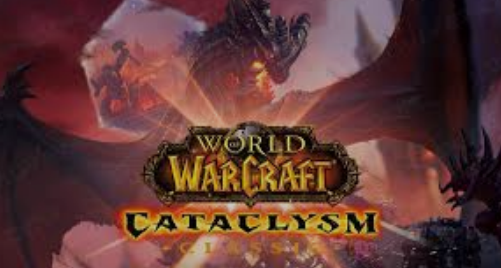As Blizzard continues to explore and expand the Classic WoW experience

The Legacy of WoW Cataclysm Classic: A Deep Dive into the Expansion’s Revival
"World of Warcraft: Cataclysm" was a transformative expansion in the history of WoW, altering the landscape of Azeroth, reworking the questing experience, and introducing a new era of game mechanics and class design. As Blizzard revisits this expansion with "Cataclysm Classic," it rekindles both nostalgia and WoW cataclysm Gold controversy among the WoW community. This article explores the merits and criticisms of Cataclysm Classic, delving into its endgame content, leveling experience, character progression, class design, and the social dynamics it fosters.
Endgame Content: Balancing Casual and Hardcore
One of the core components of any WoW expansion is its endgame content, particularly raiding. In Cataclysm Classic, Blizzard has managed to strike a delicate balance between accessibility for casual players and providing a challenge for the more hardcore audience. The raids are split into two difficulty levels: Normal and Heroic, each catering to different skill levels.
Normal mode raiding in Cataclysm Classic is notably approachable. Many players report that they can join organized pick-up groups (PUGs) on Discord and clear most of the content with minimal wipes. This accessibility is a boon for casual players, who may not have the time or commitment to join a dedicated raiding guild. However, the final boss encounters, such as Nefarian in Blackwing Descent, still demand a degree of coordination and skill, ensuring that even on Normal mode, players must engage with the game’s mechanics.
Heroic mode, on the other hand, is a different beast. It offers a substantial challenge, requiring tighter coordination, better gear, and a deeper understanding of each encounter. As of now, only a limited number of guilds have managed to clear all the Heroic content, highlighting its difficulty. Bosses like Nefarian and the Bastion of Twilight encounters push players to their limits, making victory all the more rewarding for those who persevere.
This tiered difficulty system creates a healthy ecosystem where casual players can enjoy endgame content at their own pace, while hardcore players can strive for greater achievements. This balance was something that earlier expansions like The Burning Crusade and Wrath of the Lich King struggled with, where content was often either too easy or too hard for certain segments of the player base.
Leveling Content: A Departure from Vanilla’s Charm
One of the most significant changes brought by Cataclysm was the revamp of Azeroth’s leveling zones. The expansion reimagined the questing experience, making it more linear and story-driven. While this new approach streamlined the leveling process, it also sparked debates within the community, particularly among those who cherished the more open-ended and exploratory nature of Vanilla WoW.
In Vanilla, leveling was a slow, methodical process that encouraged players to explore the world, often leading them across multiple zones to complete a single quest chain. This design fostered a sense of adventure and discovery, but it also meant that leveling could be a time-consuming and sometimes frustrating experience.
Cataclysm’s redesign, however, took a different approach. Each zone in the revamped Azeroth now follows a more linear questing path, guiding players from one hub to the next. This change made leveling faster and more focused, but it also reduced the sense of autonomy that many players enjoyed in Vanilla. While this style of questing allows for more coherent storytelling and a more efficient leveling process, it can also feel like the game is holding your hand, leading some players to feel disconnected from the sense of adventure that defined the original WoW experience.
Moreover, the introduction of the Dungeon Finder in Cataclysm further diminished the role of the open world in the leveling process. Players could now queue for dungeons from anywhere in the world, skipping the need to travel or interact with other players in the open world. This convenience came at a cost: the social aspect of leveling, where players would naturally encounter and team up with others in the world, was significantly reduced.
Character Progression: Customization and Complexity
Character progression in Cataclysm Classic offers a blend of old and new, with a mix of traditional RPG elements and new systems introduced in the expansion. Players can still customize their characters through talents, gear, gems, enchants, and professions, but Cataclysm also introduced new features like reforging, which added another layer of customization.
Reforging allows players to tweak the secondary stats on their gear, giving them more control over their character’s performance. This system is particularly useful for reaching hit caps or optimizing other key stats, making it easier for players to fine-tune their characters without needing to carry multiple sets of gear. While some may argue that reforging adds unnecessary complexity, others appreciate the flexibility it offers, allowing them to adapt their gear to different situations quickly.
In addition to reforging, Cataclysm also revamped many of the game’s classes, introducing new mechanics and resources like Holy Power for Paladins, Shadow Orbs for Shadow Priests, and the Eclipse bar for Balance Druids. These changes added depth to the classes, making their gameplay more engaging and dynamic. However, this also meant that classes became more complex, which was a departure from the simpler, more straightforward rotations of Vanilla and The Burning Crusade.
While some players relish the increased complexity, finding it more rewarding and engaging, others miss the simplicity of earlier expansions, where rotations were often a matter of hitting a few buttons repeatedly. The class changes in Cataclysm highlight the expansion’s broader trend towards modernization, which some players embrace, while others resist.
Class Design: A New Era of Specialization
Cataclysm was a turning point for class design in WoW. Blizzard took bold steps to redefine how each class and specialization played, introducing new abilities, revamping talent trees, and adding new resource systems. This overhaul was intended to make each class feel more distinct and specialized, offering a unique playstyle and identity.
For example, Paladins gained the Holy Power system, which added a new layer of resource management to their gameplay. Similarly, Balance Druids received the Eclipse mechanic, which made their DPS rotation more dynamic, requiring players to balance their spells to maximize damage. These changes were generally well-received, as they made classes more engaging to play, with more meaningful decisions to be made during combat.
However, the downside of this increased specialization was that it made some classes more challenging to play effectively. Players who were used to the simpler, more forgiving rotations of earlier expansions found themselves needing to adapt to a steeper learning curve. While this added complexity was a welcome challenge for some, it also alienated players who preferred a more straightforward approach to gameplay.
Despite these challenges, the overall reception to Cataclysm’s class design was positive. The expansion succeeded in making each class feel more unique and rewarding to master, even if it came at the cost of increased complexity.
The Social Element: A Community in Flux
One of the most critical aspects of any MMO is its community, and Cataclysm Classic is no exception. The expansion arrived at a time when the WoW community was beginning to change, moving away from the tight-knit, server-based communities of Vanilla and The Burning Crusade towards a more globalized and fragmented player base.
The introduction of the Dungeon Finder and later the Raid Finder tools played a significant role in this shift. While these tools made it easier for players to find groups and experience content, they also reduced the need for server-based communities. In Vanilla, players would often form bonds with others on their server, as finding groups for dungeons or raids required direct interaction and communication. In Cataclysm, this was no longer necessary, as the game’s automated tools could match players with others from across different servers.
This change had a profound impact on the social dynamics of the game. While it made grouping more convenient, it also made the game feel more impersonal, as players no longer needed to rely on their server’s community to progress. Despite this, Cataclysm Classic still retains some of the old social elements, as players must still group up with others from their server for most endgame content. This provides a glimpse of the old WoW community spirit, even if it’s not as strong as it once was.
Conclusion: A Divisive Yet Pivotal Expansion
"Cataclysm Classic" is a unique chapter in WoW’s history. It represents a turning point for the game, where the old world of Azeroth was reshaped both literally and figuratively. The expansion’s streamlined questing, revamped class design, and accessible yet challenging endgame content mark a departure from the game’s roots, embracing a more modern, theme-park MMO approach.
For some, this is a welcome evolution, offering a more polished and engaging gameplay experience. For others, it marks the beginning of the end of what made WoW special in the first place: its sense of adventure, community, and simplicity.
As Blizzard continues to explore and expand the Classic WoW experience, it will be interesting to see how they balance these competing visions of what World of Warcraft should be. Whether you love it or hate it, Cataclysm Classic is a crucial part of WoW’s legacy, and its impact on the game—and its community—will be felt for years to
WoW Cataclysm Classic Gold for sale come.





